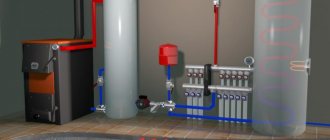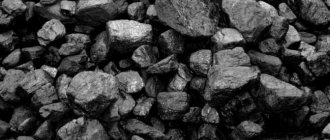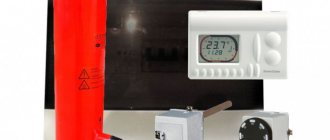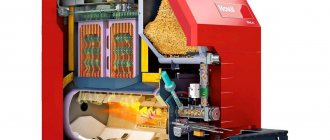A country house must have heating, even if it is a seasonal home. Depending on whether the house will be habitable in winter or not, the type of heating and its arrangement are selected. This could be capital heating of a country house with all safety devices and an automation system, or it could be simple heating of the necessary rooms with electrical appliances - in any case, the premises need to be heated at least to a minimum extent so that the structure does not begin to prematurely collapse from constant exposure to moisture and dampness .
Heating equipment in a country house
Types of heating systems and units
Which heating system for a country house to choose, which energy carriers will work in the circuit, how to install and use heating, depends on an extensive list of factors. These include existing utilities (gas, electricity, water supply), and the layout of the premises in the house, and the building materials from which the house is built, and the number of residents, and the frequency of visits to the house in winter. Even the type of foundation affects the effective heating of a summer house in winter.
There are several options for heating systems that are offered to the consumer depending on the energy resources that can be used in the house:
- Heating is on gas;
- Heating by electric appliances with or without water heating connection;
- Conventional wood (coal) stove, fireplace;
- Liquid fuel or solid fuel heating units at the dacha in winter;
- Universal heating boilers.
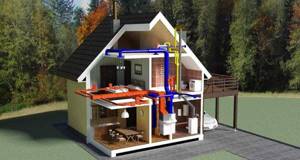
Country heating in a 3-D project
Solving the heating problem
The operating principle of water heating is not complicated. The design consists of a heating device, pipes and heating devices, which are closed into a single system.
The heating boiler creates the required temperature of the coolant, which uses water or antifreeze. The heated coolant moves through the pipeline to radiators, which are installed in heated rooms. The latter transfer the resulting heat into the atmosphere of the room, thereby warming it up. The coolant that has given off heat, moving through the pipes, returns to the boiler, where it is heated again. Then the cycle repeats.
Depending on the method of moving the coolant, the heating system can be with natural or forced circulation.
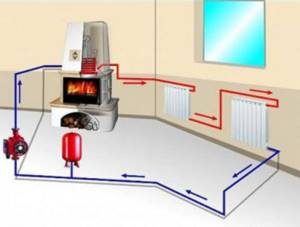
Coolant circulation system
Natural circulation
The operation of the heating system is based on the difference in density of heated and cold liquid. The heated coolant has less mass, so it moves upward when moving through the pipes. As it moves, the temperature decreases and the density of the substance decreases, so it tends downward when returning to the boiler.
The operation of the heating system in this case does not depend on electricity, which makes it completely autonomous. In addition, the design of such heating is significantly simplified.
The disadvantage of such a heating system is the significant length of the pipeline, as well as the need to use large diameter pipes. This circumstance increases the cost of the structure.
In addition, in this case it is necessary to create a pipe slope and there is no possibility of using modern heating devices.
Forced circulation
When creating a heating system in a country house with forced circulation of coolant, a pump is included in the circuit, creating pressure. Also, such a design provides for the installation of an expansion tank, which is necessary to remove excess fluid in the system. The design of the tank can be open or closed. Using the second option is preferable, since evaporation losses are eliminated. If the coolant is a non-freezing solution, then the tank must have a closed design. A pressure gauge is installed to control the pressure.
If such a heating design is used, it becomes possible to use less coolant, reduce the length of the pipeline and reduce the diameter of the pipes. The temperature can be adjusted in each heating device individually.
The circulation pump requires an electrical connection. Otherwise, the system will not work.
Gas heating of a country house
Gas heating boilers are the most economical and efficient devices for heating homes, but greater savings are observed with permanent and year-round residence in the country. The combustion of gas and its conversion into thermal energy occurs in a gas boiler, which, using a pump, supplies the heated coolant to heating radiators throughout the house. To operate without constant human supervision, gas equipment is equipped with a control and automation system, so you can safely leave the house unattended for a while if you heat it with gas.
The disadvantage, or rather inconvenience, is that when tapping into the central gas main, you need to issue a large number of permits, install a gas meter, and for all this you will have to contact the appropriate specialists, which also requires certain expenses.
Gas can be not only main-line, but also bottled, which greatly simplifies the connection, but complicates the operation of the equipment: you will have to constantly monitor the fuel level and change cylinders. But if you are far from the gas mains, this is a good solution.
Gas boiler in the country
A cylinder, or a group of cylinders, is connected to the boiler through a reducer. This use of gas is more economical, and when it becomes possible to connect to the central gas pipeline, this is very easy to do using minimal re-equipment of the system. But even for such a scheme for connecting gas to a heated dacha, you will need permission from the gas service, connecting a meter and the participation of gas specialists. Connecting any gas source yourself will result in heavy fines for you.
Gas heating from propane cylinders
Electrical heating – boilers and heaters
Another way to heat a country house? Any home always has electricity, and this is not the cheapest, but the most accessible way to equip a heating system. Any electrical appliances are small in size, modern electrical equipment will fit perfectly into the interior of the dacha, and installation, care and maintenance of such systems always takes a minimum of time and does not require special skills.
To economically heat your dacha, you can install an electric boiler with water heating, or simply use individual electric heaters for each room, which will undoubtedly be more expensive than a single system. Electric water heating works in the same way as gas heating - the coolant heated in the boiler moves through a radiator system using a circulation pump. There is no need to describe the operating principle of electric air heaters, fan heaters, infrared emitters, convectors and oil heaters - everyone knows perfectly well how it works.
It is not possible to heat a dacha efficiently and in the best way with electric heaters - to do this, you need to heat all the rooms at once, which will lead to a large consumption of electricity. It will be more economical to connect an electric boiler and water heating. These can be ordinary water radiators or a “warm floor” system, as with gas equipment. The use of piece electrical appliances will be even more ineffective if the dacha has a basement and/or attic.
Electric home heating options
The advantage of good electric boilers is silent operation without emission of smoke, combustion products and odors, as well as simple installation of equipment that does not require permission from government agencies, plus absolute environmental friendliness of operation, an automatic monitoring and control system in the winter season and a high level of any safety - fire, sanitary, electrical, chemical, etc.
Among the disadvantages, one can note the high energy consumption of any electrical appliances. The average power of an electric boiler is 3.5-7 kW, an electric heater is 1-2.2 kW, and for these devices it will be necessary to equip a separate electrical panel, connect RAM and other devices for automatic operation in case of accidents and overloads, and also, possibly, connect three- , and not a single-phase electrical network.
Electrical panels for electrical equipment
Alternative heating technologies using electricity
In addition to gas or electric heating equipment, how can you heat your dacha using other methods and devices? There are quite a lot of alternative options, in some cases more profitable, sometimes easier to install and operate, but most often they are used if it is better to heat the dacha in the cold season, but only when residents come to it, that is, periodically.
Electric infrared emitters are the most advantageous electrical equipment when choosing how to heat your dacha in winter. Infrared radiation does not heat the air in the house, but objects, which then gradually release heat into the room. Such objects also include the walls of rooms, and this is a very large area, so with such a large heat transfer coefficient, electricity consumption will be minimal, and the heating effect will be maximum. Typically, such heaters are installed as high as possible, and often on the ceiling.
IF heater in the country
Electric fireplaces are characterized by high electricity consumption and serve more as an element of interior design rather than for heating. Although, if you do not save on electricity, such a device will heat the room very quickly.
Electric fireplace in the country
Convectors are high efficiency, low price, lightweight and convenient design, which can be stationary or mobile, which allows you to place the device anywhere in the room. No special installation is needed - the convector can stand on its own legs, on wheels, or (in a stationary version) hang on brackets on the wall.
Convectors in stationary and mobile versions
Oil-filled electric radiators consume more electricity than others, as they have a high heating inertia. But they also cool very slowly, without consuming electricity. Such devices are also available in stationary or mobile versions.
Oil radiators for heating cottages
Thermal electric ventilation devices are what you can use to heat your dacha in winter as an alternative heating method. The devices are quite cheap, and they warm up rooms much faster than other equipment, since warm air is supplied into the room from a spiral using a fan. The disadvantages include noisy operation and drying of the air, which is undesirable when children are in the room.
Fan heater models
Stove heating of a dacha
How to heat a dacha if neither electricity nor gas has been supplied yet? The solution is an ordinary wood-burning stove in its classic design. A brick structure takes a long time to heat up, but also retains heat for a long time, and the use of coal makes such a stove an indispensable assistant in heating a dacha. There is energy savings, high inertia of the stove, and with proper equipment of the stove, it is possible to cook food, heat water for domestic needs, and you can even make water radiator heating without a pump - according to the principle of natural circulation of hot water. The only drawback of stoves is the high fire hazard, especially in wooden houses. In addition, a separate room or building must be allocated for firewood or coal, and in order to maintain the fire, you must have a constant supply of fuel in front of the stove itself, that is, an additionally allocated and fenced small place.
In addition to a brick stove, you can build an ordinary potbelly stove or fireplace:
Options for wood stoves for summer cottages
A fireplace is equipment that you can not only build yourself, but also buy a ready-made metal product with additional options. Homemade fireplaces offer a wider opportunity to experiment with both area and shape and content. In addition, even a factory-made fireplace can be improved at least externally - for example, by covering it with decorative facing bricks.
Potbelly stoves are not only the usual homemade stove made from an iron barrel or welded steel sheets. Modern factory-made potbelly stoves are quite suitable for installation in the most common premises; they are made in different shapes and can be filled with a wide variety of functionality, for example, cooking or heating water for domestic needs, which would not be a problem at the dacha. Therefore, how to heat a dacha in winter is decided by choosing among the huge variety of proposed solutions. For example, if I heat my dacha with wood, then I have a choice of a regular stove, a Russian stove, a fireplace, a potbelly stove, and a solid fuel boiler.
Factory stove with cooking stove
Liquid fuel boilers
A boiler using diesel fuel, exhaust gas, fuel oil or kerosene does not work as an independent unit - it, like other boilers, must be connected to a liquid heating system with radiators, batteries or registers located in all living rooms of the dacha. The disadvantage of such heating is the need for a separate room or building for the boiler room, as well as a place for storing liquid energy. The room must be ventilated and equipped in accordance with fire safety rules.
ZhT boilers can be equipped with one or two circuits. One circuit is only heating the dacha without the possibility of organizing hot water supply, the second circuit is used to heat water for domestic needs. A double-circuit boiler can be with a built-in boiler (to save fuel with low water consumption), or with a flow-through heater, including an electric one. According to their design, HT boilers can be floor-mounted or wall-mounted.
Liquid fuel boiler
Floor heating equipment is quite large in size, so it is recommended to install it in a separate room. In addition, any liquid fuel equipment produces characteristic loud sounds. Wall-mounted boilers can be installed in the kitchen, and additional functionality is used to suppress noise; they are smaller in size, but such a boiler will not be able to heat a large dacha.
Solid fuel heating devices
Heating equipment that runs on solid fuels (firewood, briquettes, coal, pallets, shavings, sawdust, straw, peat, etc.) is becoming increasingly popular due to the rise in prices of other energy sources and the fairly cheap price of solid fuels of natural origin. Such boilers also work only in tandem with a water system for delivering coolant to heated rooms.
Solid fuel heating boiler in a separate room at the dacha
Advantages of TDK - reliable operation, simple maintenance, the ability to independently install equipment, inexpensive price, the ability to use different solid fuels, the main types of which were listed above, autonomy of operation and safety monitoring systems, long burning time of one batch of fuel - from 18 hours to two days .
Negative aspects in the operation of solid fuel boilers are low efficiency, requirements for a constant supply of fuel, the need for a separate room or building for its storage, constant cleaning of the chimney and combustion chamber from soot.
jsnip.ru
What is the advantage of a long-burning stove?
Any person who starts assembling a long-burning stove sets himself the main task: to make with his own hands something that will work efficiently with minimal consumption of materials and fuel. It is worth noting that most ready-made stoves of this type have an efficiency much lower than home-made models.
An ordinary factory stove is distinguished by the fact that the fuel in it burns very quickly, so the room quickly heats up and then quickly cools down if more fuel is not added to it. This is extremely inconvenient and irrational.
There is also an alternative on sale: these are stoves that run on solid fuel, which can delay the combustion process and, accordingly, insulate the room for a longer period. Such designs operate on coal, firewood and all kinds of waste. However, such a finished unit is not cheap and has such disadvantages as:
- low efficiency;
- lack of automatic fuel loading;
- the need for regular bookmarking.
All of the above does not apply to long-burning stoves. Thus, one load of fuel can ensure the operation of the structure for approximately 18 hours due to the fact that in the firebox, over time, combustion is replaced by smoldering, and in this case automatic fuel filling is no longer needed. In addition, the design can be thought out in such a way that sawdust or wood chips can be used as fuel, rather than whole firewood.
What to consider before assembling a long-burning stove
Please note that building a long-burning stove with your own hands is a dusty and noisy job, so think carefully about the place where the work will be done. In addition, ensure that there is a source of electricity at this location, since electric welding will be required
The tools for work should be prepared as follows:
- Metal barrel 200 l.
- Two pieces of steel pipe, one larger, the other smaller.
- Metal channel.
- Hacksaw, steel hammer, axe, mallet.
- Tape measure or answer for measurements.
- High quality red brick (about 50 pieces).
- Reflector (if available).
- A set of electrodes and a welding machine.
- Sheet steel.
- Construction mixture or materials for preparing mortar for laying bricks.
Algorithm for assembling a homemade long-burning stove
The assembly of this unit consists of the following steps:
- Prepare a metal barrel: cut off its top with a grinder and leave it for later. If there is no barrel, you can take a large diameter pipe section.
- Weld a bottom from a piece of round steel sheet to the section.
- We cut out another circle of steel with a diameter slightly smaller than the barrel or pipe, and in it there is another one for a small pipe of about 12 cm. The pipe section is welded to the steel circle.
- Weld channels to the bottom of the circle, measuring them so that they can fit freely in the pipe. These will then be applied to fuel pressure based on burnout.
- The length of the welded pipe must exceed the height of the main part by 10 cm.
- Let's start with the upper part of the structure: take the part of the barrel that was initially cut off and cut a hole in it for a small diameter pipe.
- Cut out the hatch for storing fuel; then a door will be welded to it, which can be purchased ready-made or made yourself. A handle needs to be welded to the door so that it can be opened comfortably.
- Install another smaller door below to make it possible to dispose of fuel waste.
Preparing the foundation and constructing a chimney for the stove
To install a furnace, a solid foundation is required, since the furnace metal will become very hot during operation. It is strictly forbidden to install it on fragile or insufficiently fire-resistant material.
It is not worth doing deepening, since the specific gravity of the structure is not very large. You need to fill the slab, laid next to one brick, with a special solution or mixture.
Now let's move on to the issue of installing a chimney. It is needed so that combustion products quickly evaporate from the room into the atmosphere. To construct it, you can take a metal pipe with a 15-centimeter diameter. It should be welded to the top or sides of the stove structure.
Then it is bent, but not more than 40 degrees. In general, you need to make sure that there are as few knees as possible before leaving the room.
Sometimes it is necessary to install a reflector, especially for small rooms. Thanks to them, heat flows will be redistributed and regulate uniform heating of the entire room.
There is no need to cover the stove with bricks if it is located in a boiler room or other utility room where children do not have access. If it is installed in full view of everyone, then it is better to do the cladding for safety reasons.
Heating a dacha with wood: advantages
Of course, this option for heating a room is considered one of the simplest, however, it has a number of advantages:
- Wood-burning heat generators allow you to quickly heat a room.
- This type works without batteries and piping systems, which eliminates the need to install them.
- Small stoves fit perfectly into small spaces and also provide additional cooking surface.
- A wood heating boiler is considered one of the most environmentally friendly types of units.
Moreover, this kind of stove provides an atmosphere of warmth and comfort, and the crackling of firewood in the hearth creates an unforgettable impression of harmony and love. In addition, wood heating of a country house also has a positive effect on the health of its inhabitants, due to the high environmental friendliness of wood as a type of fuel.
In addition, it is beneficial in terms of material costs. In addition, if there is a small forest next to the house, the question of how to heat the house with wood disappears by itself. Moreover, the whole installation looks very nice both in person and in photos and videos.
Disadvantages of a wood-burning system
As for the disadvantages, in this case we can highlight two of the most significant:
- Firstly, wood heaters are not small in size. Provided that the original floor plan did not include space for the stove, erecting the entire system may be difficult. This is explained by the fact that in addition to the main structure, it is also necessary to consider the location of the chimney, as well as places to store firewood, since heating a dacha with a wood-burning boiler will require quite a lot.
- Secondly, this is the danger of the system itself. Thus, many advise, in the absence of previous experience in handling such structures, to use the help of a specialist. Do-it-yourself heating with wood must be carried out in accordance with all fire safety requirements.
However, when the fireplace is fully loaded, heating a wood-burning cottage will allow you to maintain the optimal temperature in the room for 12 hours.
What heating to choose for a country house, detailed video:
teplospec.com
How to make wood heating correctly
Modern wood heating of a country house differs significantly from old schemes. Large brick kilns are practically no longer used for this purpose. They served as a heat exchanger - when heated, their surface transferred heat to the air in the room. However, they were replaced by modern wood heating in the country with the installation of boilers, pipe distribution, radiators and radiators.
A special feature is the ability to use several types of structures for burning wood - stoves, fireplaces or boilers. It all depends on the area of the house, the possibility of placing heating devices and the budget of the entire event. In order to make wood heating for a private house with your own hands, you will need to take into account the following factors:
- Required thermal power of the system . Depends on the degree of thermal insulation of the house, its volume and climatic characteristics of the region;
- The need to organize a separate boiler room . It is important to know that a wood-burning boiler for heating a house must be installed in a separate room, which has special requirements;
- A place to store a supply of firewood . According to safety regulations, it is prohibited to store solid fuel in the same room as the boiler.
What is best to choose - a wood-burning heating boiler for a summer house, a fireplace or a stove? It all depends on the parameters of the building and financial capabilities. The best option is to make water heating, in which the boiler will perform the function of heating water. For a more detailed analysis, you should weigh the pros and cons for each type of heating device.
Additionally, with heating, you can make a hot water supply system at home. To do this, you need to install a double-circuit wood heating boiler.
What kind of heating is there?
There are several types of heating.
The first and most common method is hot water. It spreads through the pipes, thereby radiating heat. This is a good way to heat apartments, offices and other similar buildings. If we take into account private houses, then it is best to use gas. The procedure is the same, but such autonomous heating is much more efficient, so it is used in private homes and buildings that require more heat
It is worth noting that the dacha is heated by supplying hot water through pipes. Since not many people can afford to supply gas to their dacha. But for those who can afford to install gas, it is best to use the gas heating method. This is also beneficial because in the gas version, there is less heat loss - this allows you to significantly save resources. After all, gas is quite expensive.
Wood heating schemes for a house
The key point in designing wood heating is the choice of scheme. It depends on it whether a wood-burning heating boiler will be installed with your own hands or whether its functions will be performed by a stove or fireplace. To determine the optimal option, it is necessary to take into account all possible factors.
First of all, the area of the building and the number of rooms are taken into account. Most often, wood-burning heating stoves for summer cottages are installed if there are a maximum of two rooms. In this case, there is no need to create a water heating system.
Let's consider the main factors influencing the choice of heating type:
- Vodyanoye . It consists of a boiler (stove, fireplace) connected to a pipeline. The transfer of thermal energy occurs due to installed radiators. The best option for a house with an area of 80 m² or more;
- Pechnoye . Wood heating stoves are used to heat the air in the room. They are characterized by low efficiency and small heating area. However, their arrangement requires the least amount of effort. The exception is structures made of fireclay bricks. This type is used to heat houses with an area of less than 60 m²;
- Fireplace . Analogue to furnace heat supply. The difference will be in the size of the combustion chamber - in a fireplace it is much larger. In addition, heating a private house with a wood-burning boiler sometimes implies the presence of a hob in the design.
As you can see, the choice of option directly depends on the area of the house. It must be taken into account that the wood heating circuit can be modernized. It is enough to install a heat exchanger in the furnace to make it possible to provide a full water heat supply.
But the most common option is to install a wood-burning boiler for heating the house. It is much more practical and easier to use than a fireplace or stove.
For normal operation of wood heating in a country house, it is necessary to think through the chimney system in advance. The optimal diameter of the pipe and its height are taken into account.
A brief overview of metal stoves for heating a summer house
Heating and heating-cooking stoves, popularly called potbelly stoves, are the simplest metal stoves. These stoves heat the house by direct radiation of thermal energy and heating the air directly from the walls and chimney. Such a stove quickly warms up the room and then cools down just as quickly after burning the fuel. Among the disadvantages of such ovens is the possibility of getting a burn from direct contact with the surface. Currently, they are represented by a wide range of new and modern models, high-quality made and with an interesting design, in contrast to their predecessor, welded by a familiar welder from scrap materials.
Diagram of the Russian stove.
Furnaces with a built-in heat exchanger are a kind of mini-boiler room. Heating radiators need to be connected. The operating principle of these furnaces is as follows: directly next to the firebox there is a heat exchanger in which antifreeze or other liquid is heated, which then enters the radiators. From the heating radiators, the cooled antifreeze flows back into the heat exchanger, and so on in a circle. The advantage of this type of heating stoves is the rational use of thermal energy, when higher efficiency is obtained with lower fuel costs. Successfully heats a room with an area of 100-250 m².
A design feature of air heating boilers (convection ovens) is a special device - a casing - additional channels for heating air coming from outside. Warm air, according to the laws of physics, always rises. It is on this principle that the operation of these furnaces is built. Between the walls of the casing, it is repeatedly heated and rises, this is called convection, which is the basis for the name of these ovens. The outer walls of ovens in this category do not heat up to such an extent that you could get burned on contact, which makes them much safer to use, especially if you have children. It can heat a dacha very quickly and then retain and release heat for a long time. Of course, this is a big plus for country houses. Provides heating for rooms ranging from 100 to 1000 m².
Scheme of a wall-mounted fireplace.
Particular attention should be paid to metal stoves and fireplaces. The main difference from a simple stove is the open firebox, as in a traditional fireplace. Due to the open firebox, the room quickly warms up. In general, products in this category have high efficiency and combine the best qualities of a stove and fireplace. Additionally, they can be equipped with a small stove for cooking and an oven, which can be useful, for example, for drying fruit. Heats a room with an area of 80 to 250 m².
When purchasing a metal product, carefully inspect it for defects and compliance with the correct geometric shape. Make sure that the handles and adjustment knobs of the product are securely insulated. All moving elements must open/close without any difficulty, otherwise they may jam during operation when exposed to strong heat.
Review of solid fuel boilers
The defining component for water-based wood heating is the boiler. The parameters of all wood heating in a country house or house will largely depend on its characteristics.
Before drawing up a heating scheme, it is necessary to determine the operational and design characteristics of the boiler:
- Type of design – classic or long-burning. The cost of the latter is 50-60% more, but at the same time fuel consumption is significantly reduced, and the level of autonomy in operation increases.
- Rated power . To do this, it is necessary to calculate the heat losses in the house, which wood heating for the dacha should compensate for.
- Design features - metal thickness, its composition, shape and volume of the heat exchanger.
An important factor is the cost of heating equipment. That is why, in many cases, homemade wood-burning heating boilers are made, adapted for a specific system.
To build a full-fledged wood-burning heating stove for a summer residence, you will need to pour a separate foundation, not connected to the main one. This applies only to those cases if the mass of the future structure exceeds 600 kg.
Classic wood boilers
Often reviews of wood heating boilers indicate their low operating efficiency. This is often due to the wrong choice of model and non-compliance with installation and operation rules. This is especially true for classic wood-burning heating boilers for summer cottages.
The principle of its operation is based on the transfer of thermal energy emanating from burning wood to water in a heat exchanger. For this purpose, the design includes the following elements:
- Firebox _ Firewood is placed in it for further combustion. Its volume determines the power of a wood heating boiler made by yourself. The same applies to factory models;
- Ash pan . Performs two functions. The most important of these is the air supply to support the combustion process. It is this that creates the draft necessary for the normal operation of a homemade wood heating boiler. The second task is to collect the ash. Otherwise, it will clog the firebox container;
- Chimney . It is necessary for the removal of carbon monoxide; with its help, air draft is formed. It is important to choose the correct chimney diameter, since without this, wood heating of a private house with your own hands will reduce the efficiency and efficiency;
- Heat exchanger . In classic models, it is an area located between the inner and outer casing of the boiler. It is filled with water from the system. To connect to the heating supply of the house, the design includes pipes.
The main problem in heating a private house with a wood-burning boiler is the inability to influence the power of the equipment. To do this, you can only limit the flow of air through the ash pan, thereby reducing the amount of oxygen surrounded. In this case, the power will be largely influenced by the level of combustion of wood. Before purchasing a boiler, you need to find out the maximum length of firewood that can be loaded into the combustion chamber.
Long burning wood boilers
An alternative to classic boilers are pyrolysis models. They are also called long-burning boilers. Their operating principle differs from those described above and is based on the release of a mass of heat not from the combustion of wood, but from the gas formed during its smoldering.
There is no ash pan in the design. Its function is performed by a special air channel, which in most cases has a fan. After loading firewood into the primary chamber, it is ignited. Due to the low oxygen content in this area, the wood does not burn but smolders, resulting in wood gas. It moves to the afterburning zone, where it ignites. In the same part of the double-circuit wood heating boiler there is a heat exchanger.
How do wood stoves for a home with water heating differ from the design described above? The main advantage is the long combustion time of the fuel. In factory models, one load is enough for 4-6 hours of boiler operation. In addition to this, the following advantages can be highlighted:
- Possibility of power regulation . In wood-heating stoves, this occurs by opening (closing) the ash pan door. In pyrolysis models, the degree of water heating is controlled using the air supply speed;
- Implementation of low-temperature heating operation . The water heating level in classic models can reach +95°C. This regimen is currently considered ineffective. With normal thermal insulation of the house, the optimal mode should be 65/50. This will reduce energy consumption;
- Almost complete fuel burnout . Unlike wood stoves for homes with water heating, the intensity of chimney pollution in pyrolysis boilers is much lower.
The main disadvantage of long-burning boilers is their high cost. However, if you calculate the operating costs and fuel consumption, the economic efficiency of their installation will be obvious.
For normal operation of the wood-burning heat supply of a country house with pyrolysis boilers, it is necessary to equip it with an automatic fan intensity regulator. It can be connected to external temperature sensors.
Video description
You can see about water heating from a wood stove in the following video:
Equipment for water stove heating
For the water circuit you will need:
- pipes;
- radiators;
- water pump;
- expansion tank;
- heat exchanger;
- drain valves;
- shut-off valves;
- thermometer;
- filter.
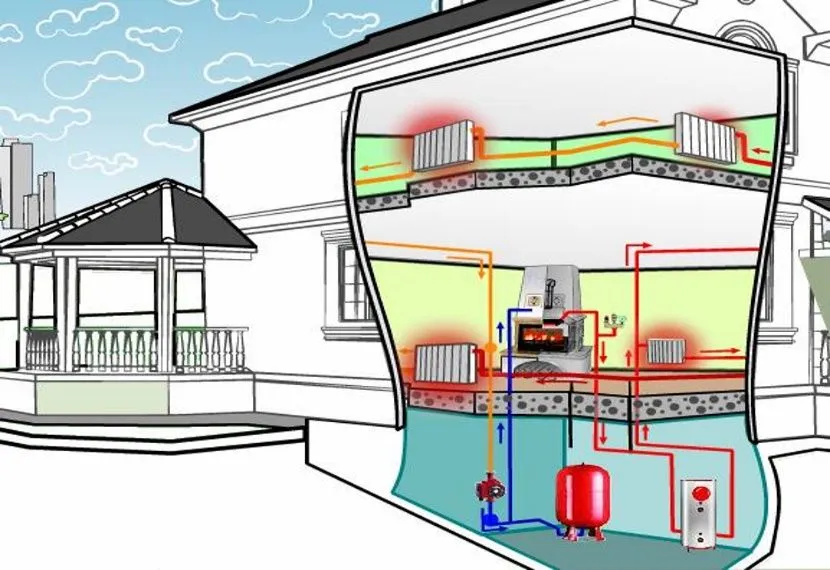
With a well-thought-out layout, stove heating can heat a fairly large house of 2-3 floors Source lestorg32.ru
Rules for organizing a boiler room for wood heating
Professional organization of wood heating of a private house independently implies the arrangement of a boiler room. This must be a separate room in which the boiler and means of regulating its operation are located.
If wood heating to the dacha is done using a gravity scheme, the boiler should be located at the lowest point of the system. There are no such requirements for forced heating. You should also prepare the room in which the heating equipment will be installed. It must meet the following requirements:
- Ceiling height – at least 2.5 m;
- Usable area – from 6 m². Moreover, its minimum volume should be 15 m³;
- Forced ventilation. The air exchange rate is three times the volume during operation of a wood-burning boiler for heating the house;
- Parameters of the chimney channel. The minimum height is 4 m. The diameter depends on the connected boiler pipe, but not less than 100 mm;
- To carry out maintenance and repair work, it is necessary to ensure free access to all sides of the wood-burning heating boiler for the cottage;
- Lighting should be combined - natural and artificial.
An important point is ensuring fire safety. To do this, it is necessary to use only non-combustible materials for finishing the room. If electric elements are used to heat a private house using a wood-burning boiler, a power line must be provided. Installation of a ground loop is carried out only at the request of the manufacturer.
One of the problems in the operation of a wood-burning stove is the possibility of backdraft. To minimize this effect, it is recommended to install a special design on the chimney.
Making a wood-burning boiler with your own hands
Is it difficult to make a wood-burning boiler for your home with your own hands? The main condition for this design is the thickness and grade of steel used. In factory models, the outer casing is made of heat-resistant steel with a thickness of 1.5 mm. For a heat exchanger, these parameters should be larger - from 2 mm.
The best option is to create a welded structure, which will be similar in shape to the factory models. However, if you calculate the labor intensity of the work and the cost of materials, the difference between purchasing and making it yourself will be small. Therefore, as an alternative to wood stoves for homes with water heating, simple steel barrels are often used. The main condition is the thickness of their walls - from 1.5 mm.
For production you will need a container of about 200 liters. It is cut lengthwise and a partition is installed inside. Its length should be less than the length of the barrel. This is necessary for the installation of grates.
Then holes are cut on the end side for mounting the doors. They should be selected in advance so as not to make a mistake with the sizes. To remove carbon monoxide, a chimney pipe is cut into the back of the structure. Its diameter can range from 50 to 100mm.
However, judging by the reviews of such a wood-burning heating boiler, the following disadvantages can be noted:
- Low efficiency rate;
- Heating of the case, which can lead to burns when touched;
- Short service life.
Similar designs are used for heating small utility rooms - garages, warehouses, etc. For your home, it is best to purchase a high-quality factory model. It will fit modern wood heating schemes.
| Boiler model | power, kWt | Cost, rub. |
| Buderus Logano G221 | 20 | 69900 |
| Dakon DOR F 24 | 24 | 60300 |
| Proterm DLO 30 | 24 | 58450 |
Before making a homemade wood-burning boiler for a heating system, it is necessary to calculate the optimal dimensions of the firebox.
How to properly light a finished stove
For heating with a wood-burning stove, you can use both classic firewood, independently chopped from tree trunks, and pellets specially prepared for this purpose - dry wooden logs, which are an excellent fuel.
You can heat such a device using coal and dry pieces of peat. Important! For long-burning stoves, it is better to use recently harvested, not yet completely dry wood, which will produce more smoke. Too damp firewood will lead to the formation of condensation and a large amount of soot, which will negatively affect the quality of heating
Stove firing plan:

- Clean the combustion chamber from the ash remaining from the last stack of firewood.
- To light a conventional stove, kindling is placed down - wood chips, sheets of paper, rags soaked in kerosene. In a long-burning device, the kindling is placed on top.
- The logs are placed in the combustion chamber, sometimes interspersed with kindling. In a conventional device, the first fill is small; in a long-burning system, the firebox should be filled almost completely.
- The kindling is ignited - in a conventional firebox from the lower rows, after the first layer of firewood has burned out, the chamber is laid so that there is at least 20 cm of free space on top. In a long-burning system, the firewood is ignited from above and when the flame flares up well, the flow of air into the chamber is minimized to the beginning of the smoldering process.
Modern wood-burning stoves for the home represent an excellent combination of high efficiency and functionality with low cost, and therefore remain in demand, despite the abundance of technical innovations on the market. Ease of operation and reliability make it possible to provide a high-quality heating system for suburban housing for many years.
Reviews about wood heating
One of the ways to choose a wood-burning stove or boiler for a summer house is a detailed analysis of reviews. They talk about the advantages and disadvantages of each of these components. However, it is worth knowing that reviews of wood-burning stoves and boilers are almost always subjective:
- Until recently, there was an old stove at our dacha. We were already thinking of replacing it with a boiler, but we did not have enough funds for this. On the advice of a specialist, a new chimney was installed - a sandwich. And what a surprise it was when the traction increased and the wood consumption became less. Conclusion - you need to first check the remaining components of the furnace, and then think about replacing it;
- After installing a long-burning boiler, the consumption of firewood decreased significantly. The only thing that was not taken into account was the mandatory insulation of the entire house. We had to urgently replace the windows with new ones;
- For the dacha we decided to use a wood stove for heating. After much deliberation, we installed a homemade heat exchanger and connected it to the pipes. The result was even better than expected. Now the house heats up much faster.
When organizing wood heating, you need to arrange a place to store fuel. This should be a room with normal room temperature and humidity. Otherwise, damp firewood will have less heat transfer.
The video talks about the basic rules of wood heating at home:
www.strojdvor.ru
Features of heating a country house
Maintaining constant heat in an empty dacha using an automatic heating system, even with a gas pipeline and uninterrupted power supply, is very expensive.
A dacha differs from a city or country house, primarily in that we do not live there permanently. If this does not create any problems during the warm season, then visiting a cold, frozen house for the weekend does not cause positive emotions until this house warms up.
You can use a more economical heating option - using a boiler that runs on solid fuel or diesel fuel. But in the absence of the owners, a strong drop in ambient temperature can cause water in the pipes to freeze, which will ultimately lead to depressurization of the system and a serious accident. So the owner of a country house finds himself faced with the problem of how to relatively inexpensively create and maintain a comfortable temperature in a home that is used only a few times during the cold period of the year. This is where ovens come to the rescue.
Advantages and disadvantages of stove heating
If a rural house with stove heating is used as a dacha, then the question is what type of fuel to choose. Coal has more calories, when it burns, more heat is released, and a coal stove maintains its temperature longer. But it cannot be easily purchased everywhere; coal combustion products have an unpleasant odor and can lead to poisoning if safety precautions are violated.
Heating with wood is a more environmentally friendly method; wood ash is used as fertilizer, heating the house relatively quickly . And the aesthetic pleasure that a person experiences while sitting by a stove with burning wood is important when choosing a method of heating a country house. The problem is that quite a lot of firewood is consumed for heating; it needs to be prepared in advance and stored, preferably in a dry, ventilated area. Yes, and you need to constantly add firewood to the stove, it quickly burns out.
When building a country house, the problem of its heating must be solved at the design stage. All the nuances must be thought out: what financial resources do you have, how often will the dacha be visited during the cold season, and even whether, after a long ski trip through the winter forest, you want to find yourself in a warm and cozy house or prefer to sit quietly by the stove, periodically throwing firewood into it and admiring the burning coals.
http:
Modern methods of heating a dacha with wood
If you have the necessary funds, often use your dacha and don’t want to work all weekend as a stoker, then you can consider some other methods of heating your dacha with wood.
Bulleryan stove. Under this name, a whole range of heating devices are manufactured, the principle of which is that air is supplied to the bunker where the firewood slowly smolders. As a result, generator gas with a high CO content is formed. This gas burns almost completely with a uniform and long-lasting heat release. And the pipes built into the structure ensure rapid removal of heated air and heating of the next portion according to the principle of convection.
http:
Small in size, compact, bulleryans can heat a room with a volume of up to 100 cubic meters, if there are no obstacles to the movement of air. The efficiency of these devices reaches 80%, the burning duration of a single load of fuel is 9-12 hours. In addition, they have a fast heating mode, which, according to user reviews, allows you to raise the room temperature to +18⁰ C in 4 hours when the outside temperature is -25⁰. These stoves are not suitable for heating dachas with several isolated rooms; the firewood must be well dried, and their operation also requires strict adherence to certain safety regulations.
Wood boiler. If your dacha has a complex architecture and consists of several rooms and floors, then you cannot do without a water heating system consisting of a boiler, pipes and radiators. Solid fuel boilers are available in various models and prices; their efficiency is not very high (60-65%), but higher than that of a stove (up to 40%). Loading fuel and cleaning the boiler is carried out approximately once every 6-8 hours. And if you replace the water in the heating system with antifreeze, the problem of pipe ruptures during extreme cold weather is solved.
Pyrolysis boiler using pellets. If you still dream of an automated heating system for your dacha, but for some reason it is impossible to install an electric or gas boiler, consider an option that is very popular in Europe due to the ability to automate the process and the low cost of the fuel used.
http:
A pyrolysis boiler is a product of modern technology, operating on the principle of a gas generator, and has an efficiency of up to 90%. Pellets are obtained by processing waste from the wood processing industry into compact granules. The cost of pellets is much lower than the cost of liquid or gaseous fuel, which is also growing all the time. In addition, this is an environmentally friendly raw material; it burns almost completely, without emitting substances harmful to health. The process of filling pellets, ignition, and waste removal is automated, and the operating time of the boiler without human intervention is determined only by the capacity of the pellet hopper, and then comes down to adding fuel pellets to the hopper. Heating using such a boiler has the only drawback - the very high cost of the equipment itself and the need for an uninterrupted power supply to operate the built-in fan.
davaistroy.ru
Brick stoves-fireplaces for a summer residence
Brick stoves are, without a doubt, a more durable option than any metal ones. But their main difficulty is the need for the services of a professional stove maker, who will assemble the structure so that it does not smoke and effectively warms the house. You can cook food on such a heating device.
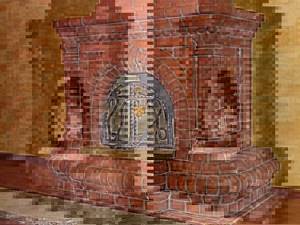
If desired, you can order a fireplace stove to admire the open fire
For summer cottages, compact structures are usually built that do not take up much space. Here are some options.
Russian
The traditional Russian stove has excellent efficiency - about 35-50%. The only drawback of this design is that it warms up the room, leaving the floor cold.
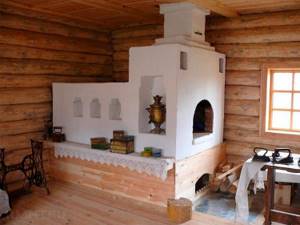
A real master will build your smoke circulation channel in such a way that the heating will reach the entire height of the stove. In this case, the efficiency will increase to 80%
Another drawback is the massiveness of the device. But here you can build a sun lounger, which will be so pleasant to warm up after a cool day. To cook or heat up lunch, you need to get the hang of working with a grip and acquire special utensils.
Dutch
Dutch ovens can be called more compact than Russian ones. The smallest possible size is 50x50 cm².
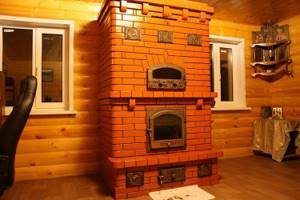
Due to its compactness, the structure does not weigh much. It’s quite possible to put it even on the second floor
The walls of this heating device are relatively thin, but, thanks to their special design, they do not deform when overheated. It’s easy to build a tank for heating water and even an oven into a Dutch oven. One such stove can heat a house with a total area of 60 m².
Swede
The heating unit, using Swedish masonry technology, heats up much faster than its Russian counterpart and is “powered” not only by wood, but also by coal. It only takes about 15 minutes to warm up the room, no more.
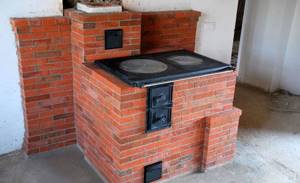
Like the Dutch oven, this stove takes up little space and can have an oven, hob and water heater in its design
During construction, it is important to choose the right brick, since low-quality material significantly reduces the efficiency of the furnace.

